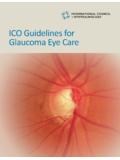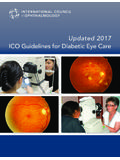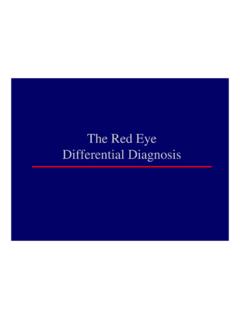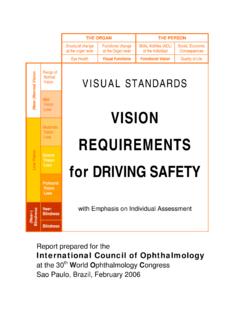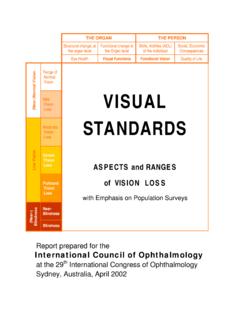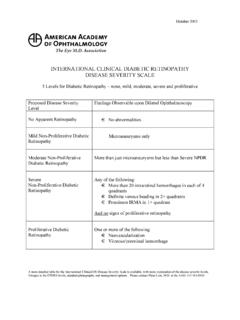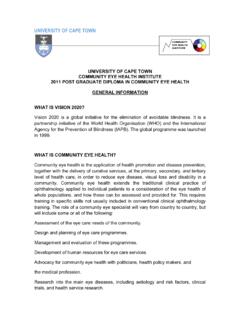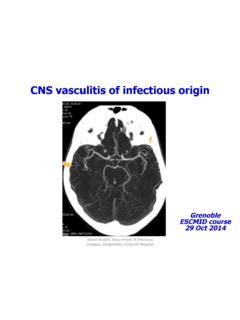Transcription of Ocular manifestations of HIV infection
1 Ocular manifestations of HIV infectionIntroduction AIDS is an infectious disease caused by the gradual decrease in CD4+ T lymphocytescausing subsequent opportunistic infections and neoplasia. It is a blood borne and sexually transmitted infection caused by the HIV (Human ImmunodeficiencyVirus) Approximately 36 million persons around the world are infected. Up to 70% of patients infected with HIV will develop some form of Ocular involvement, ie: direct infection by HIV,opportunistic infections and neoplasia. HIV infection progresses though different phasesOcular manifestations correlating with immune status and stage of HIV infection When the CD4+ count deteriorates, the immune system fails and symptoms such as malaise, night malaise, night sweats, fever and loss of sweats, fever and loss of weightweightdevelop as the infection progresses.
2 Measuring the absolute CD4+ count is an essential part of the staging the +External eyeAnterior segmentPosterior segmentNeuro-ophthalmicseroconversion100 0 InflammedconjunctivaDry eyeHeadacheRetro-orbital painEarly HIV infection500-1000 Allergic conjunctivitisReiter s syndromeIntermediate uveitisRetinal vasculitisHIV retinopathyOptic neuropathyIntermediateinfection200-500 Dry eyeBlepharitisBacterial andfollicularconjunctivitisKaposi s sarcomaMolluscumcontagiosumHerpes zosterHerpes simplexHIV retinopathyTberculous uveitisAspergillosisLate0-200 Opprtunistic infections and tumours affecting all Ocular structuresAdapted from and with curtesy of PJ McCluskey.
3 Overview of HIV infectionand pre-AIDS Ocular manifestations , HIV and the eye, S Lightman ED, ImperialCollege Press London, 2000 Ophthalmic manifestations of HIV infection AROUND THE EYE Molluscum Contagiosum Herpes Zoster Ophthalmicus Kaposi s Sarcoma Conjunctival Squamous Cell Carcinoma Trichomegaly FRONT OF THE EYE Dry Eye Anterior Uveitis BACK OF THE EYE RetinalMicrovasculopathy CMVR etinitis Acute Retinal Necrosis Progressive Outer Retinal Necrosis Toxoplasmosis Retinochoroiditis Syphilis Retinitis Candida albicans endophthalmitis NEURO-OPHTHALMICM olluscum Contagiosum Molluscum contagiosum is a viral infection of the skin. Affects up to 20% of symptomaticHIV infected patients.
4 Clinically appears like painless, painless, small, small, umbilicated umbilicated nodulesnodules, which produce a waxy dischargewaxy dischargewhen pressured. Treatment consists on excisionexcisionof the lesion, curettagecurettageor cryotherapycryotherapyHerpes Zoster Ophthalmicus Due to the reactivation of a latent infection by Varicella Varicella Zoster VirusZoster Virusin the dorsal root of trigeminal nerve gangliontrigeminal nerve ganglion. It manifests with a maculomaculo--papulopapulo--vesicular rashvesicular rashwhich often is preceded by pain. Usually involves the upper lid and does does not cross the midline not cross the midline Treatment consists on oral AciclovirAciclovir800mg 5 times /day.
5 In immunocompromisedpatients Acicloviris given intravenously for two weeks. Ocular manifestations such as anterior uveitis, are treated with topical steroids and steroids and s Sarcoma Kaposi s sarcoma is a vascular neoplasmvascular neoplasmwhich is almost exclusively seen in patients with AIDS. KS is the commonest anterior segment lesionseen in AIDS; appears as a violaceous non-tender noduleon the eyelid or conjunctiva. Typically KS involves only theskinskinbut when there is a reduced CD4 count it can progress rapidly to other sites such as the gastrointestinal tractgastrointestinal tractand CNSCNS Treatment of Ocular adnexalKS may be necessary for cosmesisand to relieve functional difficulties.
6 The mainstay of treatment is radiotherapyradiotherapy. Other options include cryotherapyor Squamous Cell Carcinoma Squamous cell carcinoma (SCC) is the third most common neoplasm associated to HIV infection . This may be due to an interaction between HIVHIV, sunlightsunlightand Human Human Papilloma Papilloma VirusVirusinfection. SCC appears as a pink, gelatinous growth, usually in the interpalpebral area. Often an engorgedblood vessel feeding the tumour is seen. It may extend onto the cornea, but deep invasion and metastasis are rare. The treatment of choice is local excision and local excision and cryotherapycryotherapybut the presence of orbital invasion is an indication of exenterationTrichomegaly Trichomegaly orhypertrichosishypertrichosisis an exaggerated growth of the growth of the eye lasheseye lashesfound in the later stages of the disease The cause is not known When symptomatic or for cosmetic reasons the eyelashes can be trimmed or pluckedDry Eye Sicca Sicca syndromesyndromeis frequent among patients with HIV infection Patients complain of burning uncomfortable red burning uncomfortable red There are several causes of dry eye in HIV infection from
7 Blepharitis blepharitis to destruction of the to destruction of the lacrimal lacrimal glandsglands. Treatment is with tear tear supplements supplements Anterior Uveitis HIV related anterioruveitis can be: Direct manifestationDirect manifestationof the human immunodeficiency virus infection autoimmnuneautoimmnunein origin drug induceddrug inducedie: rifabutin, secondary to direct toxic effect upon the non-pigmented epithelium of the ciliary body Any of the different infections infections associated with AIDS, ie: Herpes Zoster Virus, Herpes Simplex Virus,Cytomegalovirus, Toxoplasma gondii, SyphilisRifabutininduced anterior uveitisRetinal microvasculitis Retinal microvasculopathyoccurs in more than half of the patients with HIV It is seen as transient cotton wool spots (CWS), intra-retinal haemorrhages and microaneurysm, which occurs in 50-70% of patients.
8 It is usually asymptomaticusually asymptomatic. It has an unclear pathogenesis, but it is thought to be HIV infection of retinal vascular cells. In an otherwise healthy individual the presence of CWS, should be differentiated from other forms of retinopathy, such as diabeticor hypertensive retinopathy. Serological test for HIV will confirm the diagnosis Treatment is based in delaying the progression of the disease associated with HIVC otton Wool SpotsCMV Retinitis Introduction CMV Retinitis is the commonest intraocular Ocular opportunistic infectioncommonest intraocular Ocular opportunistic infectionseen in patients with AIDS Antibodies are found in almost 95% of adults, causing a trivial illness in immunocompetentadults.
9 However severe immunosuppressioncauses viral reactivation and tissue invasive disease Pathogenesis Reactivation from extraocularsites leads to seeding in other sites such as the retina Epidemiology The number of newly diagnosed cases of CMVR has decreased since the introduction of the HAARTCMV Retinitis Clinical manifestations Patients may complain of minor visual symptoms such as floaters, flashing floaters, flashing lights or mild blurred visionlights or mild blurred vision, or be totally asymptomatic. It presents with a wide range of clinical appearances. From cotton wool spotscotton wool spotswhich may look like HIV Retinopathy to confluent areas of full thickness retinal necrosis and necrosis and vasculitisvasculitis.
10 CMVR can progress in a brushfire pattern brushfire patternfrom the active edge of an active lesion. The retinal vessels in an affected area show attenuation, becoming ghost vesselsghost vesselseventually. Treatment The treatment of CMVR in patients with AIDS requires the use of specific antiviral agents, ganciclovirganciclovir, , foscarnetfoscarnetor cidovircidovirin conjunction with HAARTHAART. These treatments can be administered orally, intravenously or intravitreally. Systemic treatment has the advantage of treating infection elsewhere in the body as well as the other eye but has the disadvantages of systemic side effects. Intravitrealimplants release the drug over a six-month period, achieving prolonged high RetinitisAcute Retinal Necrosis ARN is a confluent peripheral whitening of the retina with marked vitritisand blood vessel neuritis and retinal detachment are frequent complications.

